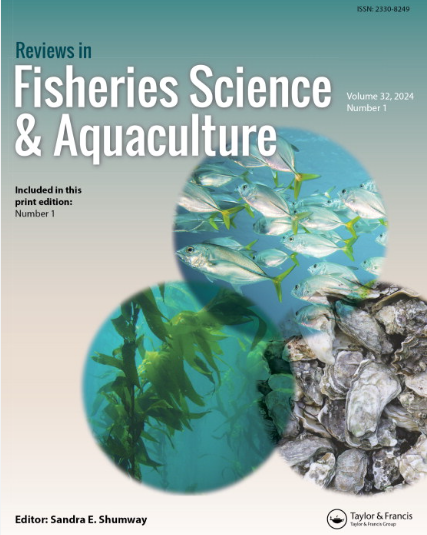Distribution, Deposition, and Modelling of Lipid and Long-Chain Polyunsaturated Fatty Acids in Atlantic Salmon Fillets
IF 5.3
1区 农林科学
Q1 FISHERIES
引用次数: 4
Abstract
Abstract This review focuses on an understanding of lipid distribution and deposition dynamics in Atlantic salmon and explores the extent to which these can be predicted through multi-dimensional modeling. The methodology used to measure lipids can have an impact on their assessment and considerable work has been done to standardize and develop robust rapid assessment measures. The distribution of lipids in salmon fillets is spatially variable, with levels consistently highest in the belly region and lowest in the tail section. The level of lipids in the whole-body, fillet and Norwegian Quality Cut (NQC) of Atlantic salmon increases with fish size but plateaus as size increases. Lipid levels are predictable based on fish size data although there are various other factors that influence lipid deposition in the fillet. The relationship between these factors and the deposition of n-3 LC-PUFA is mathematically complex but does lend itself to multidimensional modeling. Effects are strongly influenced by dietary fatty acid composition and for the most part a “parity” exists between levels of certain fatty acids in the diet and what ends up in the body tissues. This parity results in a “dilution effect” that generally explains the relationship between diet and whole-body fatty acid levels. Some specific fatty acids demonstrate traits of selective retention in Atlantic salmon muscle tissue. Notably, docosahexaenoic acid is preferentially retained compared to other fatty acids. Which is explained by the understanding that not all fatty acids dilute at the same rate and biologically active fatty acids, like EPA, are essential for mediating inflammatory responses and have a critical role to play in biosynthesis. There are various influential dietary factors in addition to the level of specific fatty acids in the diet, that affect the level of deposition of n-3 LC-PUFA in the muscle.大西洋三文鱼鱼片中脂质和长链多不饱和脂肪酸的分布、沉积和建模
摘要这篇综述的重点是了解大西洋鲑鱼的脂质分布和沉积动力学,并探索通过多维建模可以预测这些动态的程度。用于测量脂质的方法可能会对其评估产生影响,在标准化和制定强有力的快速评估措施方面已经做了大量工作。三文鱼柳中脂质的分布在空间上是可变的,腹部的脂质含量始终最高,尾部的脂质含量最低。大西洋三文鱼全身、鱼片和挪威优质三文鱼(NQC)中的脂质水平随着鱼的大小而增加,但随着大小的增加而稳定。根据鱼类大小的数据,脂质水平是可以预测的,尽管还有各种其他因素会影响鱼片中的脂质沉积。这些因素与n-3 LC-PUFA沉积之间的关系在数学上很复杂,但确实有助于多维建模。影响很大程度上受饮食脂肪酸成分的影响,在大多数情况下,饮食中某些脂肪酸的水平与最终进入身体组织的脂肪酸水平之间存在“平衡”。这种平价导致了“稀释效应”,这通常解释了饮食和全身脂肪酸水平之间的关系。一些特定的脂肪酸在大西洋鲑鱼肌肉组织中表现出选择性保留的特征。值得注意的是,与其他脂肪酸相比,二十二碳六烯酸优先保留。这可以解释为并非所有脂肪酸都以相同的速度稀释,生物活性脂肪酸,如EPA,对介导炎症反应至关重要,在生物合成中发挥着关键作用。除了饮食中特定脂肪酸的水平外,还有各种影响饮食的因素,这些因素会影响n-3 LC-PUFA在肌肉中的沉积水平。
本文章由计算机程序翻译,如有差异,请以英文原文为准。
求助全文
约1分钟内获得全文
求助全文
来源期刊

Reviews in Fisheries Science & Aquaculture
FISHERIES-
CiteScore
25.20
自引率
0.90%
发文量
19
期刊介绍:
Reviews in Fisheries Science & Aquaculture provides an important forum for the publication of up-to-date reviews covering a broad range of subject areas including management, aquaculture, taxonomy, behavior, stock identification, genetics, nutrition, and physiology. Issues concerning finfish and aquatic invertebrates prized for their economic or recreational importance, their value as indicators of environmental health, or their natural beauty are addressed. An important resource that keeps you apprised of the latest changes in the field, each issue of Reviews in Fisheries Science & Aquaculture presents useful information to fisheries and aquaculture scientists in academia, state and federal natural resources agencies, and the private sector.
 求助内容:
求助内容: 应助结果提醒方式:
应助结果提醒方式:


